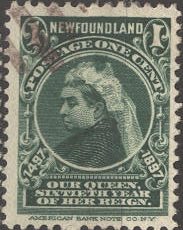
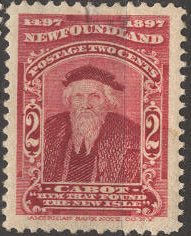
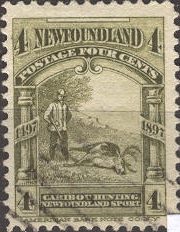
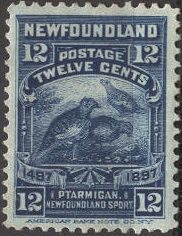
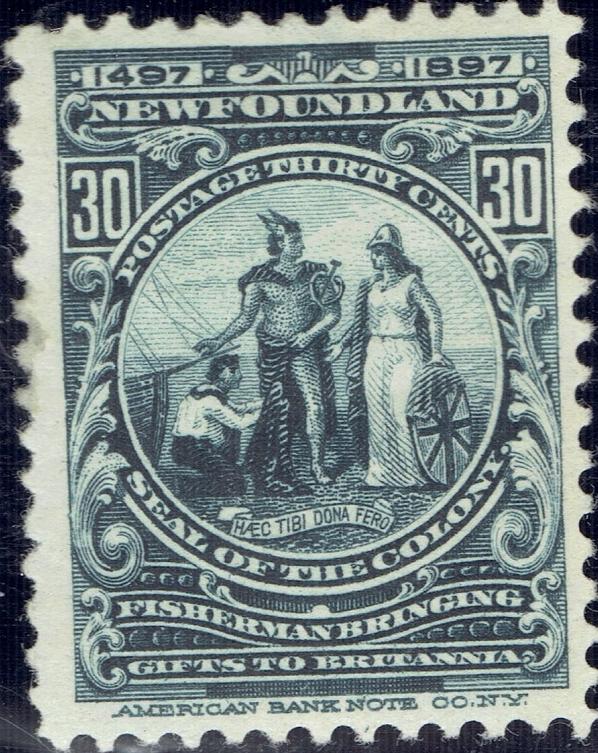
Return To Catalogue - Newfoundland 1857-1896 issues - Postal Stationery and Fiscal stamps - Canada
Note: on my website many of the
pictures can not be seen! They are of course present in the cd's;
contact me if you want to purchase them: evert@klaseboer.com.
1 c green 2 c red 3 c blue 4 c green 5 c lilac 6 c brown 8 c orange 10 c brown 12 c blue 15 c orange 24 c violet 30 c black 35 c red 60 c black Overprinted 'Trans-Atlantic AIR POST 1919 ONE DOLLAR'
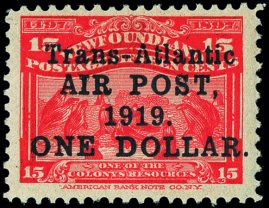
15 c orange Overprinted 'AIR MAIL to Halifax, N.S. 1921'
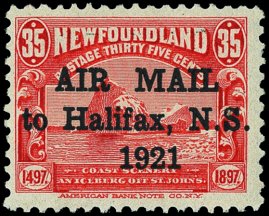
35 c red Surcharged (1920)
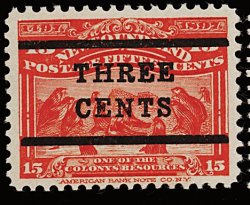
2 c on 30 c black 3 c on 15 c orange 'THREE CENTS' on 35 c red
These stamps are perforated 12.
Value of the stamps |
|||
vc = very common c = common * = not so common ** = uncommon |
*** = very uncommon R = rare RR = very rare RRR = extremely rare |
||
| Value | Unused | Used | Remarks |
| 1 c | c | c | |
| 2 c | c | c | |
| 3 c | c | c | |
| 4 c | * | * | |
| 5 c | * | * | |
| 6 c | * | * | |
| 8 c | * | * | |
| 10 c | * | * | |
| 12 c | * | * | |
| 15 c | * | * | |
| 24 c | ** | ** | |
| 30 c | ** | ** | |
| 35 c | *** | *** | |
| 60 c | *** | *** | |
| Surcharged | |||
| 2 c on 30 c | ** | ** | |
| 3 c on 15 c | ** | ** | Two types of overprint, differing in the distance between the two bars: 10 mm or 14 mm. |
| 3 c on 35 c | ** | ** | |
| 'Trans Atlantic Airpost 1919' | |||
| 1 $ on 15 c | R | R | |
| 'Airmial to Halifax 1921' | |||
| 35 c | *** | *** | |
1/2 c olive 1 c red 1 c green 2 c orange 3 c orange 4 c violet 5 c blue
These stamps are perforated 12, but some rare imperforate stamps exist.
Value of the stamps |
|||
vc = very common c = common * = not so common ** = uncommon |
*** = very uncommon R = rare RR = very rare RRR = extremely rare |
||
| Value | Unused | Used | Remarks |
| 1/2 c | c | c | |
| 1 c red | c | c | |
| 1 c green | c | vc | |
| 2 c | * | * | 2 Shades of colour |
| 3 c | c | vc | |
| 4 c | * | * | |
| 5 c | * | c | |
2 c red
This stamp is perforated 12.
Value of the stamps |
|||
vc = very common c = common * = not so common ** = uncommon |
*** = very uncommon R = rare RR = very rare RRR = extremely rare |
||
| Value | Unused | Used | Remarks |
| 2 c | c | c | |
1 c green 2 c red 3 c olive 4 c violet 5 c blue 6 c lilac 8 c brown 9 c green 10 c black 12 c brown 15 c black
These stamps exist with several perforations.
Value of the stamps |
|||
vc = very common c = common * = not so common ** = uncommon |
*** = very uncommon R = rare RR = very rare RRR = extremely rare |
||
| Value | Unused | Used | Remarks |
| 1 c | c | c | |
| 2 c | * | c | |
| 3 c | ** | ** | |
| 4 c | ** | ** | |
| 5 c | * | * | |
| 6 c | *** | *** | |
| 8 c | *** | *** | |
| 9 c | *** | *** | |
| 10 c | *** | *** | |
| 12 c | *** | *** | |
| 15 c | *** | *** | |
A 5 c stamp with overprint 'Money Order Stamp Tax only' (two types, with and withour stop after 'only'), is a fiscal stamp issued in 1914.
1 c green 2 c red 3 c brown 4 c violet 5 c blue 6 c grey 8 c blue 9 c violet 10 c green 12 c lilac 15 c red
These stamps are perforated 14.
Value of the stamps |
|||
vc = very common c = common * = not so common ** = uncommon |
*** = very uncommon R = rare RR = very rare RRR = extremely rare |
||
| Value | Unused | Used | Remarks |
| 1 c | c | vc | |
| 2 c | * | vc | |
| 3 c | ** | ** | |
| 4 c | * | * | |
| 5 c | * | * | |
| 6 c | ** | ** | |
| 8 c | *** | *** | Exists on white or blue paper |
| 9 c | ** | ** | |
| 10 c | ** | ** | |
| 12 c | ** | ** | |
| 15 c | ** | ** | |
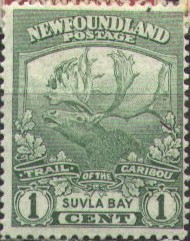
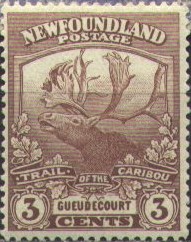
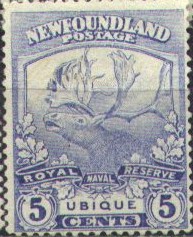
1 c green (Suvla bay) 2 c red (Ubique) 3 c brown (Gueudecourt) 4 c violet (Beaumont Hamel) 5 c blue (Ubique) 6 c black (Monchy) 8 c lilac (Ubique) 10 c black (Steenbeck) 12 c orange (Ubique) 15 c bue (Langemarck) 24 c brown (Cambrai) 36 c green (Combles) Overprinted 'FIRST TRANSATLANTIC AIR POST April 1919'
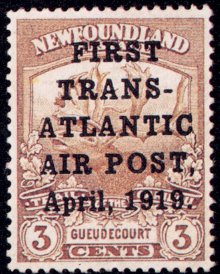
Only 200 stamps were issued with this overprint. 15 got damaged
and were destroyed I've been told. 95 were actually used, 11 were
given away and the rest was sold to help the Marine Distasters
Fund. Many forged overprints exist (see image below for an
example).
3 c brown Overprinted 'Trans-Atlantic AIR MAIL Bv B.M."Columbia" September 1939' 'Fifty Cents' on 36 c
These stamps have perforation 14. 'Ubique' is the Latin word for everywhere.
Value of the stamps |
|||
vc = very common c = common * = not so common ** = uncommon |
*** = very uncommon R = rare RR = very rare RRR = extremely rare |
||
| Value | Unused | Used | Remarks |
| 1 c | c | vc | |
| 2 c | c | vc | |
| 3 c | c | vc | |
| 4 c | * | c | |
| 5 c | * | c | |
| 6 c | ** | ** | |
| 8 c | ** | ** | |
| 10 c | ** | ** | |
| 12 c | ** | ** | |
| 15 c | ** | ** | |
| 24 c | ** | ** | |
| 35 c | ** | ** | |
| 'First trans-atlanctic airpost 1919' | |||
| 3 c | RRR | RRR | |
Forgeries exist, example:
1 c green (Twin Hills, Tor's Cove) 2 c red (South West Arm, Trinity) 3 c brown (war memorial, St.John's) 4 c lilac (Humber river) 5 c blue (Coast of Trinity) 6 c grey (Upper staedies, Humber River) 8 c lilac (Quidi Vidi, near St.John's) 9 c grey (cariboes crossing lake) 10 c violet (Humber River Canyon) 11 c green (Shell Bird Island) 12 c red (Mount Moriah) 15 c blue (Humble River near Little Rapids) 20 c brown (Placentia) 24 c brown (Topsail Falls near St.John's) Surcharged (1929, issued due to a shortage of 3 c stamps) 'THREE CENTS' and bar (red) on 6 c grey
1 c green (map)
2 c red (steamship: SS Carbiou, operating
between Port-aux-Basques and North Sidney, Nova Scotia)
3 c brown (King George V and Queen Mary)
4 c lilac (Prince of Wales)
5 c black (express train between St.John's and Port-aux-Basques)
6 c blue (Newfoundland hotel at St.John's)
8 c brown (Heart's Content: relay station for transatlantic
cables from Great Britain)
9 c green (Cabot Tower)
10 c violet (war memorial, St.John's)
12 c lilac (general post office at St.John's)
14 c brown (Cabot Tower)
15 c blue (airplane, tranatlantic flight)
20 c black (parliament building)
28 c grey (post office)
30 c brown (Grand Falls on Hamilton River)
Specialist distinguish two types of the values 6 c, 10 c, 15 c and 20 c.
1 c green (codfish) 1 c grey (codfish) 2 c red (King George V) 2 c green (King George V) 3 c brown (Queen Mary) 4 c violet (Edward VIII as Prince of Wales) 4 c red (Edward VII as Prince of Wales) 5 c violet (caribou) 6 c blue (Princess Elizabeth) 7 c brown (Queen mother Elizabeth, Duchess of York) 8 c red (Corner Brook paper mill) 10 c black (salmon, king of the rivers) 14 c black (Newfoundland dog) 15 c lilac (seal pup) 20 c green (Transatlantic beacon) 24 c blue (loading iron ore) 25 c violet (sealing fleet) 30 c blue (fishing fleet) 48 c brown (fishing fleet)
15 c brown 50 c green 1 $ blue
Overprinted 'L.&.S. Post' (1933)
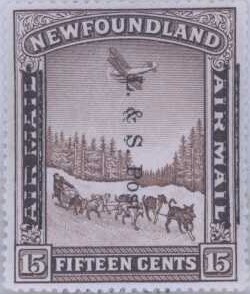
15 c brown; 'L&S' meaning for use on Land and Sea. Overprinted in red: 'TRANS ATLANTIC WEST TO EAST Per Dornier DO-X May 1932'
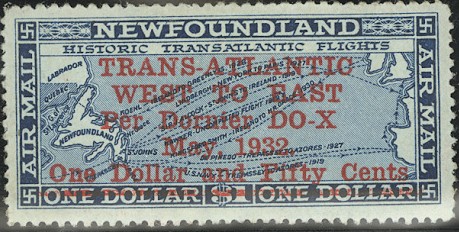
'One Dollar and Fifty Cents' on 1 $ blue
1 c black (Sir Humprey Gilbert) 2 c green (Compton Castle England) 3 c brown (arms of Gilbert family) 4 c red (Eaton College) 5 c lilac 7 c blue (the commission) 8 c orange (fleet leaving Plymouth) 9 c blue (fleet arriving at St.John) 10 c red 14 c black 15 c red (Gilbert's ship) 20 c green (map) 24 c lilac (Queen Elizabeth I) 32 c black (statue of Sir Gilbert)
5 c red 10 c orange 30 c blue 60 c green 75 c orange Overprinted 'GEN. BALBO FLIGHT $4.50' on 75 c
The Balboa stamp exists with inverted overprint (only 8 genuine stamps exist with this inverted overprint). I have seen forgeries with the inverted overprint though.
A 4 c red, 5 c violet, 7 c blue and 24 c green were issued in a design identical to many other British colonies (Windsor castle). However, for most other colonies two colours were used, the stamps for Newfoundland were printed in one colour only.
For stamps in the same design, but for another British colony, click here
The values 2 c green, 4 c red and 5 c violet were issued (design identical to that of many other British colonies).
1 c black (codfish) 3 c brown (map) 7 c blue (caribou) 8 c red (Corner Brook paper mills) 10 c black (salmon in river) 14 c black (Newfoundland dog) 15 c lilac (northern seal) 20 c green (beacon at Cape Race) 24 c blue (loading iron ore) 25 c black (fishing fleet) 48 c violet (sealing fleet)
5 c blue Surcharged '2 CENTS' on 5 c blue '4 CENTS' (red) on 5 c blue
2 c green (King George VI) 3 c red (Queen Elizabeth) 4 c blue (Princess Elizabeth, the later Queen Elizabeth II) 7 c blue (Queen Mother Mary)
5 c blue
7 c blue
30 c red Surcharged '2 CENTS' on 30 c red
4 c blue
5 c lilac
1 c green 2 c red 3 c blue 4 c orange 5 c brown 10 c violet
In 1902 some bogus stamps of Newfoundland appeared. See also: http://bnatopics.org/hhlibrary/newsletters/nfie/nfl-1991-08-w036.pdf (The Newfie Newsletter of the Newfoundland Studygroup of BNPAS, Number 36, August/July 1991). The designs are 1 c post-rider, 3 c sailship, 5 c train leaving station and 10 c steamship.
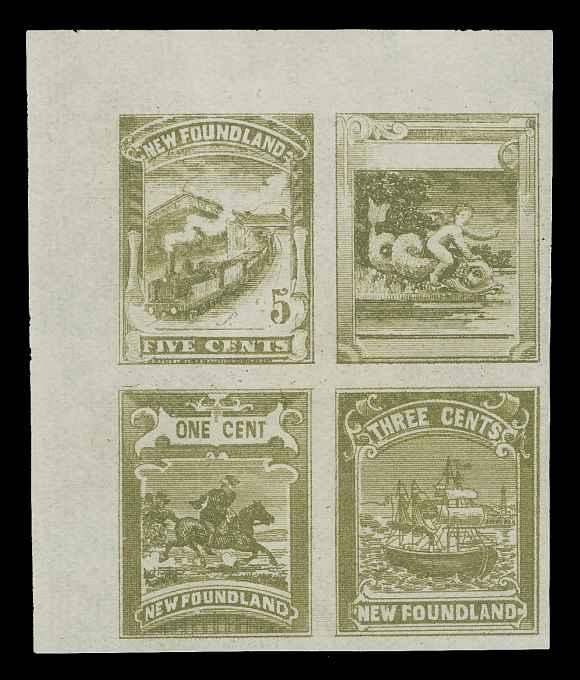
This essay from the Ed Wener collection shows a fourth design of
a child on a fish (with no value). The 10 c is not in the essay.
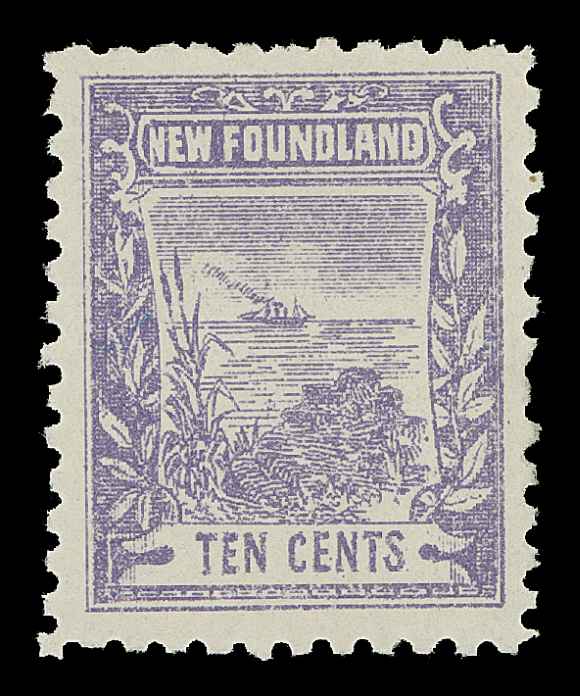
The 10 c value with steamship.

The inscription 'A.Baguet Gr. 58 Strasbourg Paris' below the 5 c
value.
Apparently the colours of each stamp can be
olive, black, purple, red, blue, brown and green (7 colours).
Under the 5 c value, the name 'A.Baguet Gr. 58 Strasbourg Paris'
can be found. This is the same Alfred Baguet who made forgeries
of the first stamps of Haiti ('Gr.' stands for 'Graveur'?).
According to the above document the name 'William B.Hale' and
'Williamsville, Mass, USA' can be found on the margins above some
3 c and 10 c values (sorry, no image available yet). This is the
same Hale mentioned in 'Philatelic Forgers, their lives and
works' by V.E.Tyler.
Baguet seems to have imprisoned in Paris in 1922 for 3 months for
forging French and French colonies stamps. He apparently also
made bogus labels for Crete. The Crete labels were printed with
the above Newfoundland stamps in one sheet of 12 stamps. Baguet
apparently also lived in 4 Rue St.Laurent (not far from the 58
Rue Strasbourg address).
The Baguet-Hale combination might also have been responsable for some poster stamps for the 1901 Pan American Exhibition at Buffalo. I have no further information.
More information can also be found in http://www.canadianpsgb.org.uk/mpl/mpl-1992-08-v022n11-w239.pdf (Maple Leaves; Journal of the Canadian Philatelic Society of Great Britain, Vol. 22, No. 11, 1992, Whole No. 239, page 376).
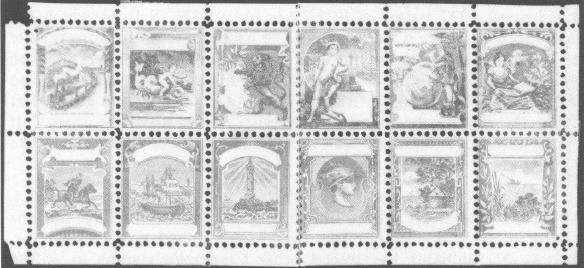
Paris essays together with two Crete bogus stamps on the same
sheet; image originally from the British Library (image appeared
in the above mentioned journal). In it, all without country
names, the train design, the child on a fish design, a lion,
Mercury, a globe, a reading lady and in the bottom row the horse
design, the ship design, a lighthouse, Mercury standing, a hut(?)
and the steamship design.
I've seen the standing Mercury design with inscription Crete (KRHTH) in the value 2 Drachmes and the Mercury head design (also with inscription 'KRHTH') in the value 5 Drachmes:
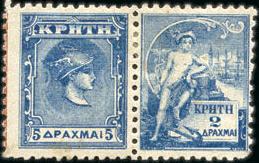
The Crete 'essays'.
In the Express du Midi of 20-December-1922 the
following text can be found on Alfred Baguet:
M. Alfred Baguet, graveur chez qui la police saisit un
matériel destiné à fabriquer des timbres et 300 kilogrammes de
vignettes estimées à 9 millions de francs a été condamné à
deux ans de prison avec sursis et à la saisie des des timbres
faux.